Women Experience Hair Loss too. We Look at the Triggers.


- More than 50% of women will experience noticeable hair loss at some stage.
- Female hair loss is more common in women in the months following childbirth.
- Changing levels of hormones can cause hair follicles to shrink and hair to thin.
- Following a nutritionally balanced diet can help reduce hairl oss.
Hair loss in women is more common than you might think. Many people assume that hair loss only affects men, and it certainly gets more attention.
Hair shedding is part of a natural balance. According to the Cleveland Clinic, on average women shed between 50 to 100 hairs each day and new hair replaces it at the same time. Your scalp hair can last on your head for up to six years. Your shorter, lighter hair – eyelashes, eyebrows, leg and arm hair – last around a month before falling out.
What is the difference between natural hair shedding and female hair loss?
Female hair loss is when a woman experiences sudden heavy hair loss or ongoing hair thinning beyond natural shedding.
There are several types of female hair loss:
- Anagen effluvium is caused by medicines, for example, chemotherapy, that poison a growing hair follicle.
- Telogen effluvium is when a higher number of follicles reach the telogen stage when hair falls out.
- Female pattern hair loss (FPHL) is when hair progressively thins across the whole scalp.
- Male pattern balding or androgenic alopecia when hair is lost at the top of the head and the sides of the frontal hairline.
The most significant cause of hair loss in women is female pattern hair loss. It’s estimated that FPHL affects some 40% of women under the age of 50.
What causes hair loss in women?
Any girl or woman can experience hair loss, however, female hair loss is more common in women in the months following childbirth; women over 40 years; women affected by drugs or chemotherapy; women who have hairstyles that pull on hair, like tight braids and cornrows, or who regularly use harsh chemicals on their hair; women with trichotillomania, a hair-pulling disorder; and menopausal women.
In addition, women who have PCOS and/or elevated levels of testosterone can experience receding hairlines, similar to male pattern baldness. This is known androgenic alopecia and
The risk factors for hair loss in women vary:
- Harsh hairstyling, heat styling and chemicals
- Nutritional deficiency
- Rapid weight loss
- Toxic substances including chemotherapy, radiation therapy and some medications
- Excessive use of some supplements
- Extreme physical or emotional stress
- Thyroid conditions
- Some autoimmune conditions such as alopecia areata and lupus
- Excess of male hormones or PCOS
- Hormone changes caused by pregnancy, menopause or birth control pills
- Genes and hereditary hair loss
- Trichotillomania
- Aging
Why do women lose their hair during and post-menopause?
There is a strong link between menopause and hair loss in women. Estrogen and progesterone levels fall during menopause, meaning that the effect of the androgens, male hormones, are increased. The changing levels of hormones can cause hair follicles to shrink and hair to thin out in some areas while growing more in other areas.
Treating women’s hair loss
Look after your hair. Be aware of and try to ease off any harsh styling. The American Academy of Dermatology (AAD) suggests, “making some simple changes to your hair care can help prevent breakage that can eventually cause hair loss.”
Try to follow a nutritionally balanced diet and avoid restrictive or rapid weight loss diets.
And speak to your healthcare provider or doctor if you are concerned about how much hair you are losing or gradual hair thinning. They may examine you for any underlying health conditions and ask about your family’s health history. They may also refer you to a dermatologist or trichologist, a specialist focused on the hair and scalp who can advise you on potential solutions and treatment options.
—
If you are concerned you may be experiencing a change in hormone levels, get tested in the privacy of your own home by ordering a blood test here.
Nabta is reshaping women’s healthcare. We support women with their personal health journeys, from everyday wellbeing to the uniquely female experiences of fertility, pregnancy, and menopause. You can track your menstrual cycle and get personalised support by using the Nabta app.
Get in touch if you have any questions about this article or any aspect of women’s health. We’re here for you.












































